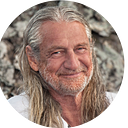My Life with U.G. Krishnamurti | Mark Whitwell
I first met U.G. in 1973 in Bangalore. He had become close with my teachers Krishnamacharya and Desikachar, having sought out their help following what he called his ‘calamity’ — the explosion of energy that occurred in him for no apparent reason when he was fifty years old. The Kanchipuram of India (equivalent to the Pope) had recently acknowledged U.G. as a jivamukti (a liberated being). And Krishnamacharya called U.G. “the greatest living yogi he had ever met,” a statement of immense significance considering his scholarship within India’s religious traditions.
U.G. would never let any category or identity stick to him, however. He detested phrases like jivamukti or enlightened man because they imply that everybody else is not yet the full-blown wonder of life. He knew that the idea of enlightenment, and the model of the perfect person, was the problem itself.
“You want to be something other than what you are. To be yourself is very easy. You don’t have to do a thing. No effort is necessary. You don’t have to exercise will. But to be something other than what you are you have to do a lot of things” — U.G.
What U.G. was constantly saying was that the body is already in a profound peace. He would bang on and on that you trying to meditate in search of peace is only disturbing the already peaceful body. “Why are you tormenting yourself trying to find something that is already the case?” He would ask. “Meditation is evil. It is a hoax pulled on humanity in the idea that there is something they have not yet realised.” U.G. demystified for everybody the constant striving that has been put on humanity.
At the time, I was travelling and teaching yoga, moving from one workshop to the next. U.G.’s communication had a big impact on my understanding of what is yoga and what is asana.
During a meeting in a hotel room in Palm Springs, he wanted to have this discussion about what is yoga and what were Krishnamacharya and Desikachar doing. He hopped up on the table and said, “This is the way that yoga looks in the body.” He started swaying very softly. He was moving with his prana. I remember getting down on the floor with him. He said that asana is the organism’s natural way of restoring itself if it has been traumatised. The body releases what it doesn’t need by moving and breathing in beautiful rhythmic patterns of breath. He called it making love with life. I fell in love with U.G. and saw him many times until his death in 2007.
What does this mean for our daily life and practice? U.G. gifted us the recognition that we are already somewhere and that we are already somebody. We are the extreme intelligence of Life Itself. We are the whole body and the whole body is already in a profound harmony with the totality of existence. There is not much more to be said. So I don’t have to meditate or yoga myself to a place of freedom. I don’t have to transform myself to fit into the molds of power structure.
“I tell you,” he once said during a talk in Saanen. “You are not an ordinary being; you are an extraordinary being. There is no one like you. You are ‘the one without a second’ that the Upanishads talked about. The ideal of the perfect person that has been placed before us has put the whole thing on the wrong track.”
Modern yoga has been turned into yet another method of seeking, of becoming something that you are not. Many teachers are show-offs who present themselves as ideals to be replicated. And good people unwittingly pass on patterns of striving in the body and mind. It is an abuse on the living organism. U.G. has clarified for all time what yoga is: participation only in your inherently authentic and unique life. He encouraged us all to stop looking and start living. Forever grateful.
- To continue the conversation and learn the yoga that is perfect for your unique life then join my friends for regular classes in the heart of yoga online studio.
